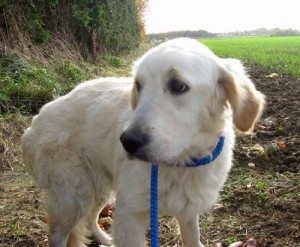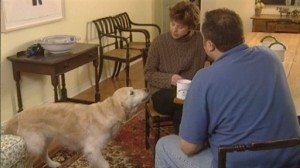Q: Hi, I have a 4 year old Golden Retriever, I have had him since a puppy, I got him from a friend who had a litter of 8 puppies so I knew his parents; who are very friendly and show no sign of aggression or anything. Since the beginning, my dog has shown signs of anxiety and is very cautious when approaching people and may even start growling at someone he doesn’t trust – this only happens with men! He has no problem with women or children.

My biggest problem was this summer at the dog park (which I now do not go anymore). My dog will get along with all other dogs except the ones who show signs of dominance and aggression, especially male pitbulls. For example, a dog that approaches him that he does not like, he will without warning attack him until either one is on his back. This happened several times – I could not walk him without a leash for fear of meeting another dog.
My dog was fixed at the age of 1, and has never been hit or beaten by a member of our family. Would the only explanation be that he was born like that? He is a very caring dog towards the family and very protective, but once out of the house I can not let him run in open fields for fear of something grave happening to my dog or someone else’s dog or even a person! What is there to do?
A: Hi there! Thanks for writing in with such a great question! I totally empathize with you regarding your situation, and your dog’s anxiety and mistrust of men, as well as his lack of confidence around other strong male dogs.
You ask if it’s possible that your dog was just born like this, and if it’s just his personality. I can assure you that he wasn’t born like this, but that this has now become a part of his personality. Often when people see a dog who is afraid of men, we rush to the assumption that some man must have beaten this poor dog at some point in his life, to imprint this fear of men onto him. I totally believe you when you say that neither you, nor any member of your family has hit, or beaten your dog!
While it is possible that some dogs who fear men may have been previously beaten by a man, the more probable reason is that the dog was never socialized properly when it was a puppy. It’s great that you met the doggy parents, both the mother and the father, and that you know their personalities, but do you know how the litter was raised, and how those 8 young pups were socialized and reared? Unless your friends are very knowledgeable dog breeders, (and not all dog breeders even take this into account) they may have no actual knowledge regarding the stages of development in growing puppies, and what their needs and requirement are.
There are 6 stages in the development of socializing a puppy. The first is the Socialization Period (5-7 weeks). This is when weaning occurs, and relationships with people start. At stage, the pup will become fearless to everything and everyone he meets during this critical period. At this point, if the pup is taken away from the mother and litter mates too early, and is hand raised, the pup can form too strong of a bond with the type of person who raised him, and may become timid as an adult, and have a hard time relating to other dogs properly.
Then there comes the Fear Period (8-10 weeks). At this stage, the dog learns very quickly, both positively and negatively. There is also a short period of high sensitivity. They are also very susceptible to physical and psychological trauma, and the effects of this can become permanent and almost irreversible.
Then there is the Competition Period (9-12 weeks). During this stage, the dog learns very quickly, and imitation is strongly practiced. This is also when the dog establishes his decision making process.
The Juvenile Period (12 weeks to 6 1/2 months) is when teething starts, and there is a period of unstable learning. The puppy is much more active and excited, which makes him more difficult to manage, and contributes to the unstable learning. The puppy also grows very quickly into an adult at this point.
The Aggression Period (4 1/2 months to 10 months) is when the puppy may start barking or growling at strangers. Puppy may also start to become territorial too. Puppy may also start to growl and bite at strangers/people and/or other dogs.
And lastly, there is the Affirmation Period (9 months to 1 year), where the puppy becomes more determined in his attitudes and behaviors, especially those regarding possessive, protective and aggressive attitudes.
As you can see, there are many critical stages in the development of a puppy. During this time, the puppy needs to be exposed to as many positive experiences as possible. The pup should meet over 100 new people within his first three months of life. All sorts of people, young, old, male, female, kids, babies, people of diff color, diff voices, you name it! He should also experience many, many different and new situations as well. He should have been exposed to new and fearful things such as cars, thunderstorms, fireworks, loud noises during his socialization period (5-7 weeks). He should have also met many types of (vaccinated) dogs as well.
And this is where I believe things started to go wrong with your dog. I believe that he wasn’t properly socialized/exposed as a young pup, and hasn’t learned the proper skills. But this doesn’t mean that your dog has to live like this forever. He can learn how to become more confident and trusting, but it will take time. It will not happen overnight, and there is no magic pill. It will take time and effort on your part.
Giving your dog jobs to do, challenging him, and working on basic obedience worked into enjoyable playtime sessions will greatly help with your dog’s confidence. It will help satisfy his ‘dogness’ and will give him some worth. I would do this at least 4-5 times a day, from 10-15 minutes each session.
When it comes to walking about and meeting new people, you should be leading the walk, so that your dog doesn’t feel the need that it’s his job to protect you. It’s your job to keep an eye out, not his. This doesn’t mean that your dog needs to be behind you, but it does mean that the walk needs to be structured, and that your dog is not the one taking you for a walk!
When you do come across people, keep walking. Keep calm. Do not force introductions onto your dog. Slowly, with enough repetition and experience, your dog will see strangers as less of a threat. When your dog does meet new people, do not be scared to tell them how best to meet your dog. They need to keep a straight posture, straight back. They shouldn’t bend over your dog, and should meet him from the side, as opposed to in front of him. They shouldn’t stick their hand out in front of his face either. Fast movements scare timid dogs, and it’s just rude to shove your hand in front of someones face. The dog can smell the person from 3-4 feet away, so there’s no need to stick your hand into his face. If the dog wants to get a better smell, the dog will move forward. Let the dog do the moving towards the person, not the other way around. If they do touch your dog, ask them to touch either his shoulder, or his chest, just under his chin. This is the least threatening to the dog. If the person needs to bend down to touch, then ask them to bend their knees, keeping their back straight, and to keep meeting from the side. If your dog doesn’t want to, gets stiff, moves away, turns his head away, starts to lick his lips, starts to yawn, drool or growl, then stop the encounter. It is very important to experience these introductions at your dog’s level of acceptance. Rushing things will only make it worse, as we need to build the dog’s trust levels.

If this happens with men who come into your home, then I’d make sure to have some tasty treats nearby, and I’d ask the man to sit on the floor, not facing the dog. The man’s side or back should be presented to the dog, and the man should hold out the treat, offering it to the dog. Let the dog move towards the man to take the treat. Again, follow through with the same type of greeting as I mentioned above. In time, this will condition your dog that men are a good thing, and that they have yummy tasty treats!
When it comes to other dogs, you are bang on with your decision to stop going to the dog park. The dog park certainly isn’t for every dog, especially for those who lack confidence. If you’d like your dog to meet new dogs, it has to be in a controlled situation, which the dog park hardly ever is.
And the issue of not being able to let your dog run off leash in a field, or in the woods for fear of him hurting someone or something is something that you might have to wait a bit for, as you really need to get your dog’s recall (come) command down pat before you start letting him off leash. I don’t think that he would bite or attack anyone out of aggression, but something could happen from a fear based situation.
Again, this is where basic obedience really comes in handy. Your dog should be able to follow some of the basic commands before you start letting him off leash. He should know how to, and perform, sit, stay and come perfectly before you let him run off. And he needs to learn these commands in many different locations, with different levels of distractions too.
It can be done! But like I mentioned before, it will take time, patience and consistency. If you’re willing to take it on, then I know you can do it!
Good luck and Happy Training!
Meira
Perfect Pet Training
514-209-0271
 Montreal Dog Blog Montreal's Online Dog Park
Montreal Dog Blog Montreal's Online Dog Park




